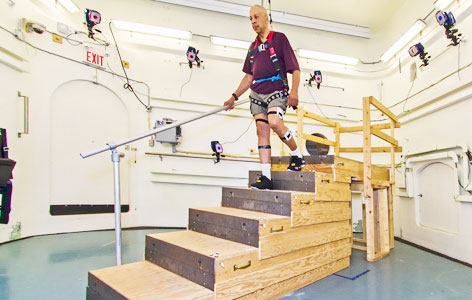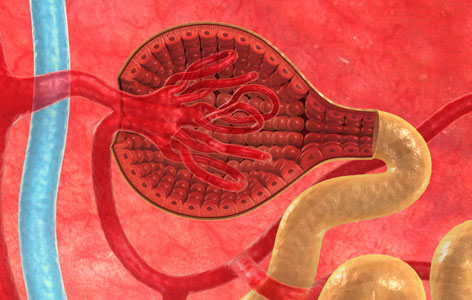 As UHN's monthly research newsletter, NRx reports on the full spectrum of research from UHN's five research institutes: the Princess Margaret (PM) Cancer Centre, the Toronto General Research Institute (TGRI), the Toronto Western Research Institute (TWRI), the Toronto Rehabilitation Institute (TRI) and the Techna Institute (Techna).
As UHN's monthly research newsletter, NRx reports on the full spectrum of research from UHN's five research institutes: the Princess Margaret (PM) Cancer Centre, the Toronto General Research Institute (TGRI), the Toronto Western Research Institute (TWRI), the Toronto Rehabilitation Institute (TRI) and the Techna Institute (Techna).
In this issue you can read about:
- How age affects the way people descend stairs
- The best way to predict risk of serious kidney disease
- A link between arthritis and vascular disease-related death
- Improved sleep apnea symptoms after removal of excess fluids in those with renal disease
- Visualizing tumours using multiple imaging techniques
- Mimicking a viral infection in cancer cells to improve outcomes
We hope that you will find NRx informative. If you have feedback or questions, please contact www@uhnresearch.ca.
Christopher J. Paige, PhD, FCAHS
Vice President, Research
University Health Network
The risk of falling is influenced by age-related differences in maneuvering stairs

During the study, body movements—including upper body tilt and foot stability—were measured while participants descended different types of stairs.
Falling on stairs is a common source of injury, particularly while going down a staircase. Each step down requires accurate foot placement while maintaining balance and stability to prevent toppling forward, due in part to the forward tilt of the upper body during descent.
Although falls on stairs can happen at any age, they are more prevalent among older adults. Little is known about the interactions between age, stair descent and stair design.
To address these relationships, TRI Scientist Dr. Alison Novak and colleagues initiated a study in which they measured the body movements of young and older adults while descending different sets of stairs; each set had a different length or height between the steps. Although the older adults had greater side-to-side movement of their upper bodies than younger adults, older adults also descended stairs more slowly so their steps were more stable. Conversely, the young adults exhibited less of a forward tilt of their upper body—decreasing their risk of falling forward—likely due to better balance control. For both age groups, the safest body posture occurred while descending stairs that were longer in length and shorter in height.
Dr. Novak's study explains how proper stair design can reinforce positive body movements that minimize the risk of falling. The research was used to inform upcoming changes to the National Building Code of Canada to improve stair design and safety; it is estimated that the changes will prevent 13,000 falls and 39 deaths due to stair-related falls over the next five years.
This work was supported by the Canadian Institutes of Health Research, the National Institute on Disability and Rehabilitation Research, the Ontario Graduate Scholarship Program and the Toronto Rehab Foundation.
Age-related differences in dynamic balance control during stair descent and effect of varying step geometry. Novak AC, Komisar V, Maki BE, Fernie GR. Applied Ergonomics. 2015 July 29. [Link to abstract]
Proper diagnosis depends on the way proteins that leak from damaged kidneys are measured

The kidney contains close to one million glomeruli that filter waste from the blood into the urine (one glomerulus is depicted above).
The kidneys perform a key function in the body: they filter waste products from the blood, while keeping in molecules that the body needs.
When the filters in the kidney (known as glomeruli) malfunction, a group of kidney diseases known as glomerulonephritis (GN) develop. For patients with GN there is often a lack of symptoms making it difficult for doctors to assess the progression of the disease. To help diagnose the stage of the disease and gain insight into outcomes, doctors measure proteins that leak from the blood into the urine from damaged glomeruli—a phenomenon known as proteinuria.
Unfortunately, there is no consensus on how to measure the degree of proteinuria or whether one approach is better at identifying people at risk of developing serious kidney disease. To address this issue, TGRI Scientist Dr. Heather Reich and Dr. Sean Barbour at the University of British Columbia led a study that assessed eight different ways of measuring proteinuria in 1,351 patients with GN.
The research team found that, at any given time, the best method to predict the long-term risk of kidney failure is to simply consider the most recent proteinuria measurement, rather than taking an average of multiple measurements or correcting the measurements for body size, as is sometimes done in the clinic.
"We found that some of the most frequently used ways of measuring proteinuria actually biased the diagnostic usefulness of the readings by up to 30%. Widespread adoption of the method that we identified as the most accurate would serve to better diagnose and monitor of patients with this disease, which would ultimately improve the care that they receive."
This work was supported by the Carraresi Foundation and the Toronto General & Western Hospital Foundation.
Identifying the ideal metric of proteinuria as a predictor of renal outcome in idiopathic glomerulonephritis. Barbour SJ, Cattran DC, Espino-Hernandez G, Hladunewich MA, Reich HN. Kidney International. 2015 Aug 19. [Pubmed abstract]
Study shows patients with ankylosing spondylitis have a higher risk of vascular-related death

People of any age can develop AS—it usually appears between the ages of 15 and 30 years, and affects men three times more often than women.
Ankylosing spondylitis (AS) is a form of chronic inflammatory arthritis that predominantly affects the spine. In addition to suffering from chronic lower back pain, patients with AS are at increased risk for heart disease and stroke. Coronary artery disease and heart attacks occur at a much higher rate in these patients, and AS has been shown to be an independent risk factor for coronary artery bypass graft surgery. Whether this translates to an increased risk of cardiovascular-related death is not known.
A recent study, led by TWRI Affiliate Scientist Dr. Nigil Haroon and his team, assessed whether patients with AS are at increased risk for mortality due to cardiovascular and cerebrovascular disease (vascular death). By analyzing the administrative health data of over 21,000 patients, they found that patients with AS were at significantly higher risk for vascular death than those without the disease. Major risk factors for death included age, chronic kidney disease and lack of exposure to nonsteroidal anti-inflammatory drugs. Moreover, male patients with AS had significantly higher mortality—whether this indicates that inflammation is less severe or that the disease is milder in women is not known.
"These findings indicate that a comprehensive strategy to screen and treat modifiable risk factors for vascular disease in patients with AS is needed," says Dr. Haroon. "Further investigation is required to study the effect of therapeutic interventions in preventing the elevated vascular mortality in these patients."
This work was supported by The Arthritis Society, the UHN Arthritis Program, the Ministry of Health and Long-term Care, and the Toronto General & Western Hospital Foundation.
Patients with ankylosing spondylitis have increased cardiovascular and cerebrovascular mortality: a population-based study. Haroon NN, Paterson JM, Inman RD and Haroon N. Annals of Internal Medicine. 2015 Aug. [Pubmed abstract]
For those with renal disease, removing excess fluids leads to improvements in sleep apnea symptoms

The interruptions in breathing from sleep apnea can lead to daytime fatigue, as well as higher risks of cardiovascular disease and motor vehicle accidents.
Sleep apnea is a common condition where breathing repeatedly stops and starts during sleep. It is especially common in patients with end-stage renal disease (ESRD), affecting up to half of these individuals. Researchers at TRI, led by Senior Scientist Dr. T Douglas Bradley, have hypothesized that fluid buildup in the body, as well as a shift in fluid from the legs towards the head at night, could contribute to sleep apnea severity.
Patients with ESRD regularly undergo dialysis to manage blood urea levels as well as fluid buildup, and those receiving overnight dialysis often have a reduction in sleep apnea severity. To test the role of fluid buildup in the causation of sleep apnea, Dr. Bradley and colleagues used a method known as ultrafiltration to remove excess fluid without performing hemodialysis. Ultrafiltration was carried out on 15 patients with ESRD on a non-dialysis day.
"Fluid removal by ultrafiltration was accompanied by remarkable improvements in sleep quality and a reduction of sleep apnea symptoms," Dr. Bradley says of the study results. "We found that the degree of improvement in patients was related to the degree of fluid volume reduction during ultrafiltration. These findings are important for our understanding of sleep apnea, highlighting the role of fluid overload in the development of sleep apnea, and also the ability to target fluid buildup for potential treatments, especially in patients with ESRD."
This work was supported by the Canadian Institutes of Health Research, Mitacs, the Canadian Thoracic Society, the European Respiratory Society, the Joseph M. West Family Memorial Fund and the Toronto Rehabilitation Institute. CT Chan holds the R. Fraser Elliot Chair in Home Dialysis and TD Bradley holds the Clifford Nordal Chair in Sleep Apnea and Rehabilitation Research.
Effect of ultrafiltration on sleep apnea and sleep structure in patients with end-stage renal disease. Lyons OD, Chan CT, Yadollahi A, Bradley TD. American Journal of Respiratory and Critical Care Medicine. 2015 Jun 1. [Pubmed abstract]
New nanoparticle helps surgeons visualize tumours using multiple imaging techniques

Bringing more advanced imaging techniques into the operating room may help surgeons safely remove tumours that have critical structures located within their proximity.
Advanced imaging techniques have been developed that give surgeons more precise control when removing tumours from locations that are complex and hard to identify.
For example, prior to cancer surgery, x-ray computed tomography (CT) is often used to construct a detailed three-dimensional image to help the surgeon visualize the tumour within complex healthy structures and to plan the optimal surgical procedure. Another imaging technique called fluorescence optical imaging is also being increasingly used for identification and surgical removal of cancer that has spread to the lymph nodes.
Until now, the combined use of these techniques in the operating room for tumour and lymph node visualization has been limited because multiple imaging agents are needed and existing agents do not have sufficient sensitivity and specificity for disease detection. Techna Scientist Dr. Jinzi Zheng and her collaborators may have found a way to overcome this limitation by developing a single injectable imaging agent that can be used for CT and fluorescence imaging of tumours and malignant lymph nodes.
Dr. Zheng and her team developed the agent by encapsulating, into a single nanoparticle, different imaging molecules that were engineered to meet the clinical requirements for CT and fluorescence imaging. Data obtained from various experimental cancer models showed that the new imaging agent improved sensitivity when mapping the location of the tumour.
Explains Dr. Zheng, "This new technology is particularly useful because it enables us to employ different imaging techniques prior to and during surgery following one injection of the imaging agent. Our preliminary results are particularly promising and suggest that this agent could be used to improve the localization, detection and removal of a wide range of cancers."
This work was supported by the Fidani Family Chair in Radiation Physics, the Kevin & Sandra Sullivan Chair in Surgical Oncology, the RACH Fund and The Princess Margaret Cancer Foundation.
A multimodal nano agent for image-guided cancer surgery. Zheng J, Muhanna N, De Souza R, Wada H, Chan H, Akens MK, Anayama T, Yasufuku K, Serra S, Irish J, Allen C, Jaffray D. Biomaterials. 2015 Jul 14. [Pubmed abstract]
Mimicking viral infection in cancer cells could decrease colorectal cancer relapse

Viruses are microscopic organisms that infect cells. They activate cell pathways that trigger an immune response to eliminate the invading organisms.
Colorectal cancer recurs in approximately 50% of people being treated for the disease. It is believed that recurrence is caused by a subset of cancer cells known as cancer stem cells, which are resistant to treatment and can multiply indefinitely. A team of researchers led by PM Cancer Centre Scientist Dr. Daniel De Carvalho has discovered a new therapeutic strategy that tricks cells into behaving like they are infected by viruses. This strategy could lead to more effective treatments that prevent the recurrence of colorectal cancer.
The researchers showed that treating colorectal cancer cells with the chemotherapy drug decitabine activates pathways that make the cells grow and proliferate more slowly and behave like they are infected with viruses. As a consequence of this, the cells are targeted and cleared by the immune system. Importantly, the researchers found that activating these pathways is effective against the hard-to-target colorectal cancer stem cells.
"By mimicking a viral infection, the immune system is tricked into seeing the cancer cells as an infection that needs to be destroyed. Our work demonstrates that viral mimicry is a viable anti-tumour strategy," says Dr. De Carvalho. Future studies will determine whether combining viral mimicry with cancer immunotherapy—a treatment that stimulates the immune system—provides more clinical benefits than either therapy alone.
This work was supported by the Cancer Research Society, the Canadian Cancer Society, the Natural Sciences and Engineering Research Council of Canada, the Ontario Institute for Cancer Research with funds from the province of Ontario, the University of Toronto McLaughlin Centre and The Princess Margaret Cancer Foundation.
DNA-demethylating agents target colorectal cancer cells by inducing viral mimicry by endogenous transcripts. Roulois D, Yau HL, Singhania R, Wang Y, Danesh A, Shen SY, Han H, Liang G, Jones PA, Pugh TJ, O'Brien C, De Carvalho DD. Cell. 2015 Aug 27. [Pubmed abstract]
 TGRI Clinical Researcher Dr.
TGRI Clinical Researcher Dr.  UHN recently hosted the Council of Academic Hospitals of Ontario's (CAHO) Innovation Tour as part of the ongoing "Healthier, Wealthier, Smarter" campaign, which showcases innovation at Ontario's 24 research hospitals.
UHN recently hosted the Council of Academic Hospitals of Ontario's (CAHO) Innovation Tour as part of the ongoing "Healthier, Wealthier, Smarter" campaign, which showcases innovation at Ontario's 24 research hospitals.  Five UHN researchers—
Five UHN researchers—